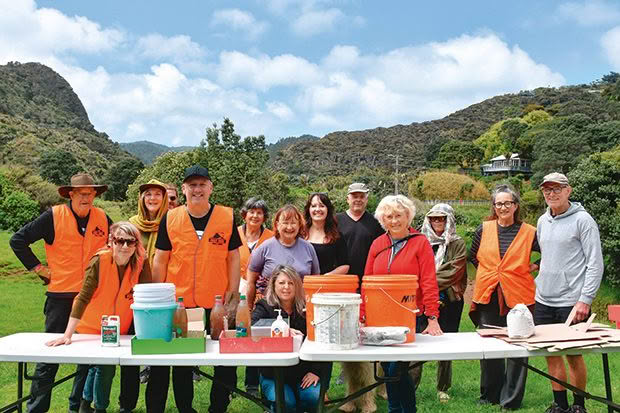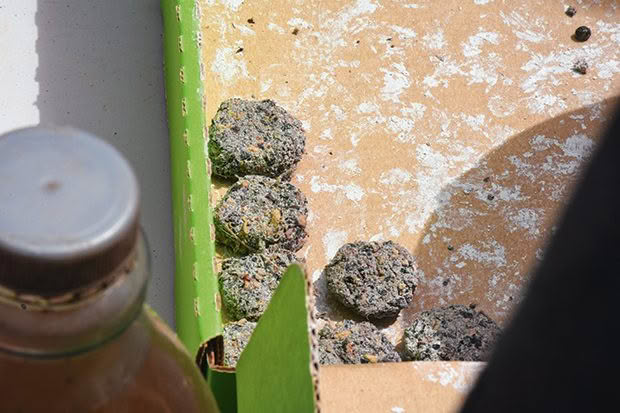Piha’s community effort to resurrect their land

Wellness company Comvita arranged a community event which saw residents shape more than 600 native seed patties.
The Piha community rallies to plant native bush on slips caused by Cyclone Gabrielle.
Words: Sarah Templeton
“It’s not for softies,” says Piha resident Peter Hosking of life in the small coastal village west of Auckland, and he should know after living there for most of 25 years.
“People fall in love with the place in the summer but, facing the southwest, it can be grim in the cold.”
Lately, it’s been far from the best of times. Piha was “absolutely smashed” (in locals’ words) by Cyclone Gabrielle at the end of January 2023. e intense rainfall caused steep slips, devastating houses in their way.
Recovery means reseeding and replanting, and the emphasis is on natives first. Permanently forested landscapes reduce slips and erosion during rainfall, keeping soil where it needs to be and creating root structures that help grip the land.
Locals called upon Pest Free Piha founder Peter for his expertise. It’s not his rst rodeo. A series of disastrous res targeted his partner’s family land during the 1990s.Since then, they’ve worked alongside the Piha Environmental Group to restore native bush. (Read more about the Pearce Bush Regeneration project at piha.co.nz.)
“After fires, the topsoil is still there and some seed — although it’s mostly weed and gorse. But with slips, the topsoil is gone — it’s at the bottom of the hill. It’s down to clay and rock, and any seed bank that was there is gone. Restoration in these situations is about getting seeds back into the slips.”
On the seed line-up? Those from more than 20 different varieties of natives. Cabbage tree/tī kōuka will provide strong and stable root structures, as do deep-rooted pōhutukawa. Kānuka is in the mix. Mānuka seeds are arguably the most important of the lot because, according to landscaper and part- time Piha resident Xanthe White, the shrub is not only as hardy as the Piha inhabitants themselves, but it also fosters an environment for other natives to grow.
“After slips, the soil is left bare without protection for seedlings to come up. So weed species dominate in the first year,” she says.
“Mānuka creates a shady canopy which restores the organic matter, creates an environment for other species bought in by birds and insects to grow — and it doesn’t need a lot of fussing around.” Some seeds were gathered from nurseries and local gardens. Mānuka honey producer Comvita organised a community seed-patty-making event. Piha residents turned out one blustery Saturday afternoon at the old Piha schoolhouse to carefully shape about 600 patties of ecologically sourced seed material into a mix of soil and clay.
One challenge came once the patties were shaped and dried: How to insert them? “Every slip is different, so you must be careful not to throw a one-way solution at it. Hills go in di erent directions — some are shady, some are sandy,” says Peter. The main issue in this coastal setting is the topography. Some slips were 45 to 95 degrees steep.
“Some we could safely climb on and insert the patties about a square metre apart. Others we will need to abseil down. Luckily, we have some accomplished abseilers here in Piha.
“Others — this hasn’t worked quite so well for us — but there is some literature on firing the patties into the slips with a catapult. We experimented with that, but because of the steepness of the slips, they were washed down by the next decent rainfall.”
A significant slip on Rayner Road is the primary site of experimentation. But the project is ongoing, and results will be seen over generations. “We have a fairly clear understanding of kaitiakitanga —
guardianship of the environment and environmental protection. Like mana whenua, we see ourselves as guardians restoring nature,” says Peter.
“We had floods here in 2018 and started developing resilience plans. They’re being dusted off now as it becomes apparent the climate will a ect us. We must improve our resilience to keep ahead of the game.”
Through it all, the Piha community will continue to work together to face these events head on. “Communities working together and supporting equals change and action. What we do as individuals in these communities reflects the world we live in,” says Xanthe. “We’re only as strong as our neighbourhoods.”
HOW TO MAKE A SEED PATTY

Seeds will germinate in soil, but sprinkling them across a slip risks them blowing or washing away in wind or rain. Seed patties resembling “tiny burger patties” are the answer.
Made up of native seeds, potting mix and clay as a binding agent, they’re wedged into the soil. “A seed patty is about the size of the main joint of the thumb and just over a centimetre thick,” says Peter.
The seeds are collected and dried before being rolled with an organic material like seed-raising mix along with china clay — the kind porcelain is made from. “Add some water to the mixture, roll it — and bang — you have a patty.”
Love this story? Subscribe now!
 This article first appeared in NZ Life & Leisure Magazine.
This article first appeared in NZ Life & Leisure Magazine.
